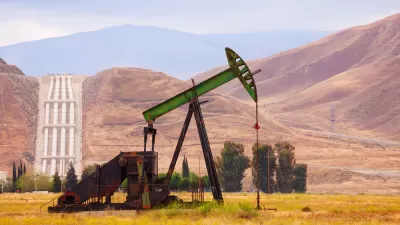Seven oil companies, including Chevron, have been injecting wastewater into 10 aquifers for decades despite never receiving permission from the U.S. Environmental Protection Agency to do so. The aquifers are not currently used for drinking water.
The order was issued by the Division of Oil, Gas and Geothermal Resources (DOGGR), part of the California Department of Conservation, was issued during the last week of December. "Teresa Schilling, spokeswoman for the resources agency, said most operators are complying or have already complied with the order," reports Peter Fimrite, who covers the environment, natural resources and public lands for the San Francisco Chronicle.
Environmentalists assert that while the aquifers are not used now, they could be tapped in the future due to an ongoing drought and climate change that will shrink the Sierra snowpack which supplies one third of the state's precious drinking water.
"This is a big deal because it's about protecting underground drinking water," said Keith Nakatani, the California oil and gas program manager for the environmental group Clean Water Action in the print edition of the article. He questioned how the "oil and gas industry has been allowed to pollute those resources for decades."
However, it's not clear that the oil companies should be held completely responsible as an oversight by DOGGR played a key role.
The oil companies had been dumping leftover water from drilling for three decades by the time state regulators found out in 2014 that the U.S. Environmental Protection Agency had never granted them permission to do so.
A July 2104 post on the "inadequate state enforcement of protected underground aquifers" was followed by an October 2014 post confirming the contamination was in violation of state law and the federal Safe Drinking Water Act.
One of the problems is that oil drilling in California produces a lot of wastewater because the the "oil fields contain large amounts of salty water, the remains of an ancient sea," explains Fimrite. "As a result, oil drillers suck up 15 barrels of water for every barrel of oil they reap." And that water has to go somewhere.
If the water is clean enough, it can be treated and used for irrigation. But most of it contains other substances too, including boron and toxins that can poison groundwater and kill birds. The recommended way to get rid of it is to inject it into the ground, preferably into the oil-bearing formation or deep enough so that it won't seep into an aquifer.
Readers may ask, "Why not force the oil companies to clean it?" That requirement was part of a controversial Monterey County local ballot measure that 56 percent of voters supported last November.
The problem is that for 33 years, state regulators have allowed oil companies to inject billions of barrels of wastewater into aquifers that contained water clean enough to be used for drinking or irrigation. Recent studies indicate that some of the injections may have caused earthquakes [in California].
The orders were directed at 30 active injection wells, nine in the Central Valley and one in Solano County, on the outskirts of the Bay Area.
The shutdown order issued during the last week of December "is part of a major statewide crackdown," reports Fimrite in the print edition.
The state has issued a Feb. 15 deadline for oil companies to halt injections in at least 50 other aquifers in the Central Valley and elsewhere unless the operators obtain exemptions.
For more information on the specific aquifers that will now be protected, see Department of Conservation: "Aquifers Historically Treated as Exempt."
FULL STORY: Oil companies face deadline to stop polluting California groundwater

Alabama: Trump Terminates Settlements for Black Communities Harmed By Raw Sewage
Trump deemed the landmark civil rights agreement “illegal DEI and environmental justice policy.”

Planetizen Federal Action Tracker
A weekly monitor of how Trump’s orders and actions are impacting planners and planning in America.

The 120 Year Old Tiny Home Villages That Sheltered San Francisco’s Earthquake Refugees
More than a century ago, San Francisco mobilized to house thousands of residents displaced by the 1906 earthquake. Could their strategy offer a model for the present?

Ken Jennings Launches Transit Web Series
The Jeopardy champ wants you to ride public transit.

BLM To Rescind Public Lands Rule
The change will downgrade conservation, once again putting federal land at risk for mining and other extractive uses.

Indy Neighborhood Group Builds Temporary Multi-Use Path
Community members, aided in part by funding from the city, repurposed a vehicle lane to create a protected bike and pedestrian path for the summer season.
Urban Design for Planners 1: Software Tools
This six-course series explores essential urban design concepts using open source software and equips planners with the tools they need to participate fully in the urban design process.
Planning for Universal Design
Learn the tools for implementing Universal Design in planning regulations.
Clanton & Associates, Inc.
Jessamine County Fiscal Court
Institute for Housing and Urban Development Studies (IHS)
City of Grandview
Harvard GSD Executive Education
Toledo-Lucas County Plan Commissions
Salt Lake City
NYU Wagner Graduate School of Public Service



























